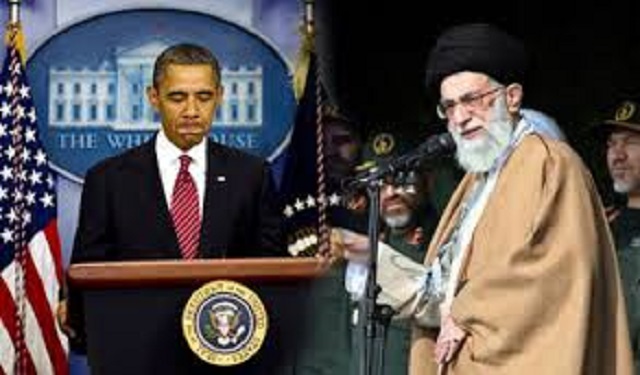Beheading, Washington style
Hisham Melhem/Al Arabiya/Saturday, 29 November 2014
The scene at the White House was painful, somber and humiliating, with some elements borrowed from Greek tragedy the way Aristotle defined it in the “Poetics.” There were two main characters, like most tragedies, one endowed with the power of a Deus ex machina, who decides the fate of mortal men; the other is the tragic victim. But unlike the huge, open horseshoe-like ancient Greek theater, the stage was tiny, and instead of a large audience, a select few invitees watched the two-scene play in two front rows and were asked to assume the role of the approving chorus. The tragedy began with a “prologue,” in this case a speech delivered by the main character to explain the essence of the play, that is the symbolic beheading of the victim, after heaping praise on his shortened and expendable life. In the second scene, the victim who appears willingly to accept the judgment of the Gods, speaks gratefully, extolls their wisdom, thanks their generosity and stoically accepts his demise.
An American ritual
Last Monday, we witnessed a time-honored American ritual; a president facing crisis, or after a bruising electoral defeat plummeting his popularity, or because of political or even personal disagreement within his administration decides that the heads of some of his officials have been ripened enough, and that the time has come for him to chop them off. Sometimes the victims deserve their judgment, and their removal serves the nation, and stand the test of time, other times they are sacrificed not because of their failings or faults, but to cover up for the failed policies and the leadership shortcomings of their presidents. The symbolic beheading of Secretary of Defense Chuck Hagel less than two years after his appointment is a salient example of the latter. Watching the cold-blooded ritualistic execution of Hagel delivered by the emotionless President Obama, and witnessed by the stone-faced Vice President Joe Biden and a small coterie of insiders who provided exaggerated fake applause to the phony exchange of praise, one immediately realizes that the proceedings lacked any of the nobility of a Greek tragedy, with maybe the exception of Hagel, whose saggy, teary eyes were screaming in silence for the mercy of the sword to deliver him swiftly.
From Lincoln to Truman
American presidents, particularly those serving a second term fire senior military and civilian officials with predictable regularity. Sometimes the sacking is brutal, but in most cases it involves a degree of deception and theater, where we are told that the offender has submitted his or her resignation and that the president accepted it “with regrets.” In some celebrated cases of well-deserved sackings the president did in fact celebrate his decision and history vindicated him resoundingly. The two most outstanding cases involve the removal of powerful and arrogant military leaders during wartime who dared to challenge the policies and orders of their commander-in-chief. In 1862, and in the wake of military setbacks and stumbles by Union forces in the Civil War, President Abraham Lincoln, who had a stormy relationship with the commander of the Union Army of the Potomac Gen. George McClellan, who openly disdained the president, decided to fire him because of insubordination and refusal to engage the talented Confederate Gen. Robert E. Lee’s Army of Northern Virginia. McClellan committed a huge tactical blunder when he could not muster enough courage to chase the exhausted and retreating Confederate army back to Virginia; following the epic but inconclusive battle of Antietam (America’s bloodiest day on Sept. 17, 1862) even though he was urged repeatedly by Lincoln to do so. McClellan’s indecisiveness contributed to prolonging the war until 1865. The abrasive McClellan called Lincoln an “idiot” and a “well-meaning baboon.” Lincoln’s biting and charming sarcasm rattled McClellan. “My dear McClellan, if you don’t want to use the Army, I should like to borrow it for a while.”
The second case was the battle royal in 1951 between President Harry Truman and Gen. Douglas MacArthur, commander of the American forces in Korea. Unlike the reluctant McClellan, MacArthur wanted to widen the theater of the war, threatening a more dangerous confrontation with China, something that Truman rejected. Truman sacked the popular MacArthur because he was “unable to give his wholehearted support to the policies of the United States and the United Nations.” Once again, Truman reasserted a cardinal concept in the American constitution: the civilian control of the military.
… And from Truman to Obama
Every president from Truman to Obama sacked senior civilian and military leaders, with some dismissing a number of senior officials at once, including Jimmy Carter, who in 1979 asked for the resignation of all members of his cabinet but accepted those of five who had strong views and national standing and clashed with him and his aides the most including Energy Secretary James Schlesinger and Secretary of Health, Education and Welfare Joseph Califano.
The Watergate scandal in 1973 caused the infamous “Saturday Night Massacre” when President Richard Nixon’s executive dismissal of independent special prosecutor Archibald Cox led to the resignations of Attorney General Elliot Richardson and Deputy Attorney General William Ruckelshaus.
Both presidents Ronald Reagan and Bill Clinton had serious second-term challenges that led to White House shake-ups, including the firing of the chief of staff, and eventual recovery. In 2006, following the defeat of the Republican Party, in the midterm election, President George W. Bush tried to salvage his second term by firing then secretary of defense Donald Rumsfeld (in a similar ritual to that of Hagel’s but less dramatic) after the war in Iraq went through a disastrous phase. But the move was seen as too little too late. It is no coincidence that those who occupied the position of secretary of defense, particularly during times of wars, would find out that their necks were most vulnerable to the president’s sword. Presidents Truman, Johnson, Ford, Clinton, George W., and Obama fired, with varying degrees of brutality their secretaries of defense, either because of their failure to prosecute the war successfully in Vietnam and Iraq (as was the case with secretaries Robert McNamara and Donald Rumsfeld) or as a sacrificial lamb to remove the blame from the president and the White House staff for their inconsistencies and lack of clarity in the current limited war with the Islamic State of Iraq and Syria (ISIS) as was the case with Chuck Hagel.
But does the beheading of senior officials help a beleaguered president recoup his sagging stature? Historian Larry Sabato, who studied the Gallup surveys following such firing from Harry Truman to Barack Obama, found out that “delivering a prominent pink slip usually had only a minor impact on a president’s popularity, even short-term. Moreover, the polling result for the president was more likely to be negative than positive.”
The long knives of the White House
Chuck Hagel did not help his fortune by his lackluster, inarticulate, and gaff-strewn confirmation hearing, which was made more pronounced by the vicious attacks by his former Republican colleagues in the Senate led by his old friend turned tormentor John McCain which gravely wounded “Sergeant Hagel.” (Politics in Washington sometimes gives meaning to the old Arab saying: they killed him, and then walked in his funeral. Senator McCain is now praising Hagel as a “friend, a patriot and a dedicated public servant … Chuck and I have worked well together, and we have seen eye to eye on our biggest national security challenges … I know that Chuck was frustrated with aspects of the administration’s national security policy and decision-making process”). But for all the criticism leveled at Hagel, by anonymous White House sources, that he was a poor manager, prone to occasional public stumbles, bereft of ideas and not forceful enough in inter-agency deliberations, belie the fact that equally inarticulate secretaries were successful when they agreed with the White House and that Hagel (who was known for his integrity and candidness and thinking on his own as a maverick when he was in the Senate) did raise some serious policy questions regarding Syria and Iraq that rankled the powers that be at the White House.
A control freak White House, still smarting from the criticism leveled at its dysfunctions by former secretaries of defense Robert Gates and Leon Panetta and former secretary of state Hillary Clinton (member of the fictional “team of rivals”), made it clear to Hagel from the beginning that national security decision-making process was, is and will continue to be the domain of the White House when they selected Hagel’s team at the defense department. Hagel, the old maverick who did not follow the Republican party line in congress, when he criticized the war in Iraq (after initially supporting the invasion) and when he did not support president Bush’s military surge, did not dance to the White House tune, on Guantanamo and the budget. Hagel now was messing with the rough edges of National Security Advisor Susan Rice, who is very close to President Obama. That was in 2013, and before ISIS forced president Obama’s hand in Iraq and Syria. From that early stage, White House aides began to sharpen the long knives for the quiet man from Nebraska. In December 2013, an article in Politico Magazine quoted a long-time Obama campaign and White House advisor assessing Hagel. “How would I describe him right now? He is a paper tiger… It’s not quite buyer’s remorse, but he needs to show us more.” In his second term, President Obama did not want to appoint strong-willed secretaries of defense and state, in the mold of Gates and Clinton, hence the choice of two old colleagues from the Senate, but Hagel did not play the part fully.
Beheading the wrong man
The reasons for Hagel’s merciless beheading as leaked to the New York Times is that it is “recognition that the threat from the Islamic State would require a different kind of skills than those that Mr. Hagel was brought on to employ.” But the reality is that Hagel was doomed to failure, given the impossibility of penetrating the thick wall Obama has built around him at the White House and is manned by a tightly knit and small group of advisors. By allowing the White House and the National Security Council to shape national security and foreign affairs, Obama made it practically impossible for Hagel even to make a serious difference.
Obama’s sacking of Hagel is reminiscent of President Bush’s firing of Rumsfeld. The difference is that in Bush’s case the firing was deserved because Rumsfeld was an active participant in the decision-making process that led to the invasion of Iraq, and his firing signaled recognition from Bush that a change of course in Iraq is imperative. Hagel is being sacrificed for a policy in Iraq and Syria that was ill-designed and ill-conceived by the president and his White House and National Security staff.
Hagel’s candid and accurate assessment of ISIS’ threat last August was chilling; it is “beyond anything we’ve seen …They marry an ideology with a sophistication of strategy and military prowess.” Earlier in July he said: “[ISIS] may not appear to be an imminent threat to the United States. It is a threat to the United States. It is a threat, clear threat to our partners in that area, and it is imminent.” It was reported that the White House was not impressed with this gloomy assessment. President Obama was slow to coming to this conclusion. In fact he was in denial early this year when he volunteered that ISIS is a minor threat using the analogy of a junior varsity basketball squad, compared with the serious (and dangerous) players.
The memo of his discontent
It was believed that Hagel, who was in constant contacts with his counterparts in the international coalition waging the limited air campaign in Iraq and Syria and heard their complaints and concerns, was urging the administration to commit more men and materials to Iraq and to escalate the air raids in Syria. Last month he may have committed the act that led to his political demise. Hagel sent a two-page memo to Susan Rice sharply criticizing the administration’s policy on Syria. Hagel raised the possibility that attacking ISIS only might indirectly strengthen President Assad’s hand. It was reported that he dismayed Susan Rice by saying that the policy does not link the air campaign against ISIS to a broader strategy that clarifies the administration’s policy toward Syria’s dictator Bashar Assad. Hagel was in fact expressing his well-founded concerns that unless the White House takes an active role against Assad the coalition might unravel given the strong views against Assad by such partners like Saudi Arabia and France. This memo expressing Hagel’s discontent with the administration sealed his fate and led ultimately to his public beheading, Washington style.
By sacking Hagel, and keeping all the members of his White House staff, President Obama will not solve his problems in Iraq and Syria; if anything he will compound them. The clarity of vision and strategy that Hagel sought through his memo is not likely to see the light. What little clarity we have on Syria and Iraq is that the president is not willing to actively seek the removal of Assad and he would like to keep the military commitment to Iraq to training and advising. The prospect of seriously accelerating training and equipping of Syria’s opposition is next to nil, especially when the administration talks about training 5,000 fighters in a year, and not to fight the Assad regime.
A hegemon named Iran
It is impossible now to understand or assess U.S. policies and approaches to Iraq and Syria (as well as Lebanon and Yemen) without factoring in Iran’s growing role as a de facto partner to the United States in the war on ISIS and in maintaining the “stability” of these brittle states. Informed sources said recently that Secretary of State John Kerry asked for a review of options in Syria but cautioned that the options should not include anything that would upset Iran and could conceivably have a negative impact on the nuclear negotiations with Tehran or its long-term strategic interests in Syria. When the recommendations were not to his liking, he returned them for further review. Turkish officials say that when they raise the issue of toppling Assad, American officials respond by expressing their concerns about what they see as the chaos that will ensue in this case, a concern, incidentally was also raised in the past by Hagel.
However, the tragic predicament of the United States in both Syria and Iraq is that Iran holds American personnel in Iraq as potential hostages. A senior U.S. official expressed this predicament in surprising honesty when asked in a not for attribution gathering; why not actively push for Assad’s removal from power? The answer was startling; we are concerned that the answer will come in the form of IEDs (improvised explosive devices) in Iraq. No wonder, Haj Qasem Soleimani, Iran’s powerful commander of the Quds Force, a Special Forces division of the Revolutionary guards Corps responsible for foreign operations and Iran’s viceroy to Iraq, Syria and Lebanon, is no longer media shy and constantly smiling these days, and taking selfies with his auxiliary forces in Iraq and Syria.





















